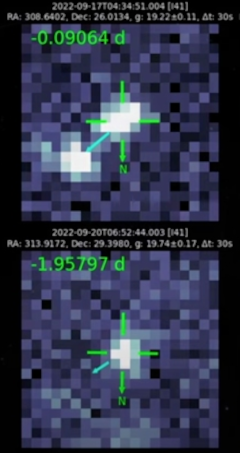Free/libre software, hardware, and ideals is building the next Space Age
Four new resources worth exploring every Friday
FOSS IN SPACE #8: HelioLinc3D
Here are this week's four free/libre space resources that are worth exploring:
1. Needle In A Haystack

A discovery of a Near Earth Object (NEO) is made when a point of light is observed in a series of night sky images moving unambiguously in a straight line. Collecting the necessary evidence can be stymied by poor weather, extreme faintness of the object, or hidden in the background glare of brighter stars. HelioLinc3D is free/libre software specifically designed for the upcoming 2025 debut of the Vera C. Rubin Observatory to discover NEOs. It has already made discoveries combining fragments of data from existing data sets, requiring half the number of images that conventional survey algorithms would use.
Link: New algorithm ensnares its first asteroid
2. Agile Orbits
Funded by the European Space Agency (ESA) and implemented by the Libre Space Foundation, the Ephemerista project is developing an Open-Source Satellite Mission and Communications Analysis Simulator Tool. It will employ various open-source astrodynamics libraries to calculate orbits, assist in mission planning, and provide a Python API for advanced automation and a web-based GUI.
Link: Ephemerista
3. Looking Down
Canadian startup Wyvern operates a growing CubeSat constellation that generates hyperspectral satellite imagery and hosts an open data program. Mark Litwintschik has posted a detailed examination of Wyvern's open data feed and the array of tools he uses to do so.
Link: Wyvern's Open Satellite Feed
4. Free Analysis
A Python module for machine learning and data analysis, astroML is built on numpy, scipy, scikit-learn, matplotlib, and astropy. The project's focus is analyzing astronomical data and provides a suite of tools and examples to study open astronomical datasets. Its paired with a textbook: Statistics, Data Mining, and Machine Learning in Astronomy.
Link: Machine Learning and Data Mining for Astronomy
Quote of the Week: "This is... a preview of the coming era of data-intensive astronomy. From HelioLinc3D to AI-assisted codes, the next decade of discovery will be a story of advancement in algorithms as much as in new, large, telescopes."
— Mario Jurić, Professor of Astronomy at the University of Washington and HelioLinc3D Team Leader
Until next week....Onward!
You can like, share, or comment on this post on the Fediverse 💬
» Next: Getting Started with OpenBSD
« Previous: FOSS IN SPACE #7: Stellarium
